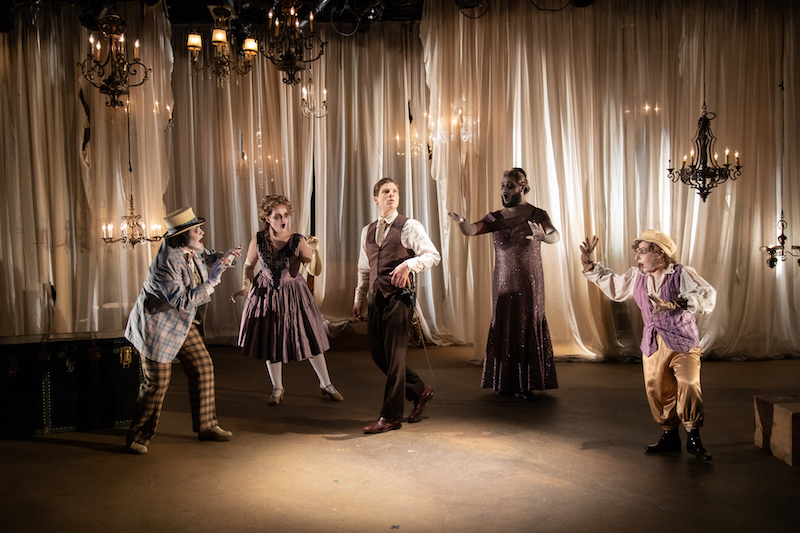The Tempest: Something Old, Something New
Review of The Tempest at Seattle Shakespeare Company.
Written by TeenTix Newsroom Writer Lucia McLaren and edited by Teen Editor Lily Williamson.

What makes or breaks a modern production of a classic story? Is it the acting, the setting, the interpretation? The large amount of “classics” available to us has lead to a pretty noticeable increase in remastered stories.
Seattle Shakespeare Company’s production of The Tempest is an example of one such creation. It tells the classic Shakespearean tale of Prospero (Mari Nelson), a banished Duke with strong magical abilities. The play shows Prospero coping with his past, as the King of Milan and others responsible for his exile find themselves stranded on the mystical island he now lives on. Everything gets more complicated as his daughter, Miranda (Allyson Lee Brown), gets tangled up in the drama, and Prospero finds himself forced to decide between revenge and forgiveness.
As an often-accidental consumer of remastered media, I was a little cautious going into Seattle Shakespeare’s production. I’m not a big fan of the head-spinning 1700’s English or the cheesy romantic plots often found in Shakespeare’s plays. And yet, I found myself caught off guard by how enjoyable the production was.

Though the story is likely familiar to those who know their Shakespearean plays, attending the production still holds some surprises. There's an incredible amount of creativity contained within almost every aspect of the production. Seattle Shakespeare Company has put passionate effort into everything from the portrayal of Prospero’s powers to the characters’ outfitting to the stage itself, and it pays off, as shown by the audience's engagement and fascination.
The production is not just modern in its artistic choices surrounding the setting, but in its construction of the characters as well. Prospero and the King of Milan, along with a few other secondary characters, are played by female actors and referred to using female pronouns. Ariel, a spirit who serves Prospero, is portrayed not by one actor but by four (Gloria Lee Alcalá, Sydney Maltese, Sidney Rakowiecki, and Malex Reed). These changes show both an attention to diversity in the world of the arts and an attempt to modernize the classic story the production is telling.
The choices made by Seattle Shakespeare Company are certainly made to separate their production from what it would've been in Shakespeare's day. But are they successful? It’s hard to generalize, but to me, it made the production a better experience. Increased diversity gives underrepresented groups the opportunity to see themselves in the production, and the artistic creativity makes the play more entertaining to watch. It both expands the possible audience and makes the experience of the show more pleasant—something that many artistic productions strive for.

One of the problems I find with modern productions of classic stories is that they’re often elusive to many. The gap becomes especially hard to cross with works like Shakespearean plays—not only is the story less relatable due to the large time gap between when it was written and the modern-day, but the archaic language can leave audience members struggling to understand exactly what’s happening.
And yet once more, Seattle Shakespeare’s production can at least partially work past this issue. The play’s language and writing weren’t changed, but the artistic decisions along with the actors’ expressions and movements aided the audience’s understanding of the plot in a way that I hadn’t seen in a Shakespearean play before.
In all, Seattle Shakespeare Company’s production of The Tempest was a refreshing and enjoyable take on a story that wouldn’t have appealed to me otherwise. It’s a good combination of old and new—mixing a classical take on Shakespeare with more modern artistic interpretations. It also appeals to a far larger audience than the classic story would. The artistic choices that producers make during these shows are becoming essential to the world of the arts as reinterpretations become more common, and it’s important for the audience to understand their own preferences in these kinds of productions.
Lead photo caption: The cast of The Tempest at Seattle Shakespeare Company. Photo by HMMM Productions.
The TeenTix Newsroom is a group of teen writers led by the Teen Editorial Staff. For each review, Newsroom writers work individually with a teen editor to polish their writing for publication. The Teen Editorial Staff is made up of 6 teens who curate the review portion of the TeenTix blog. More information about the Teen Editorial Staff can be found HERE.
The TeenTix Press Corps promotes critical thinking, communication, and information literacy through criticism and journalism practice for teens. For more information about the Press Corps program see HERE.

